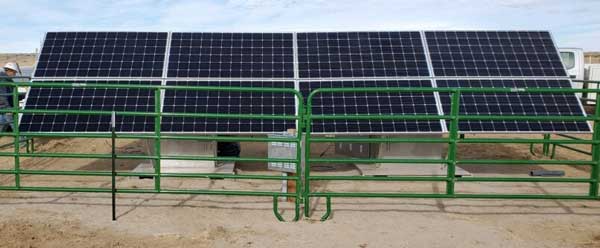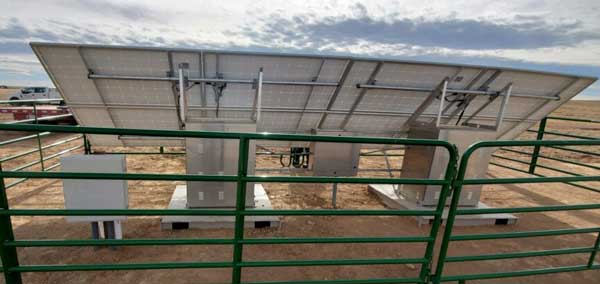This article reviews the design of solar powered cathodic protection systems to minimize power requirements.
For most impressed current cathodic protection systems, the use of AC powered transformer/rectifiers are the preferred means of supplying power to the system.
However, where AC power is not readily available, there are other alternative power supply systems available. One of the most common of these are solar powered systems.
Solar powered systems, when properly designed, can provide reliable power for an impressed current cathodic protection system where AC is not readily available. There are, however, some technical considerations that should be taken to assure that the system is cost effective and reliable.

Design of Cathodic Protection Systems to Minimize Power Requirements
This may seem obvious; however, the typical CP system design is not designed based on optimizing power requirements. For AC powered impressed current cathodic protection systems, the cost of the electrical power required is very low and the overall power draw is not significant. Therefore, CP designers focus on optimizing the overall cathodic protection installation costs and not reducing the power requirements. AC power is relatively low and AC power costs are very low.
But when we are talking about designing a CP system where AC power is not an option, the economic drivers are different.
The cost of the power supply for a solar powered cathodic protection system increases exponentially as the wattage increases. Therefore, investing additional monies on the CP system design to reduce power requirements can have a significant impact on the overall installed cost of the solar power system.
Power is simply defined by the equation W=I2R where W is Power, I is the total design current, and R is the total system resistance.
There are two ways to reduce power requirements for a solar powered cathodic protection system
The first has to do with the required current output for the system. Typically, CP designers are overly conservative in terms of design current. If we believe 20 amps of current is needed, then why not install 40 amps of capacity. If we need more current, we will have that capability by simply turning up the voltage on the rectifier. AC power is not a concern.
However, when considering solar powered CP systems, reducing the maximum current density has a huge impact on the solar system sizing.
A 25% reduction in the system’s current requirements reduces the power requirement by 44%.
For solar powered cathodic protection systems, the design current needs to be scrutinized to make sure that we are not being overly conservative and installing excessive current capacity that is not warranted by the application.

Another important factor in reducing the power requirements is designing the cathodic protection system to reduce anode bed resistance. This can easily be achieved by understanding that anode bed resistance is largely a function of the overall total anode system length. Designing the anode system to increase anode length can drastically reduce anode bed resistance. For deep anode groundbed systems this means spending a little more in drilling costs to extend the active anode length.
This will increase the cost of the CP system, but these additional costs can often generate a much larger savings in solar power system costs. Also consider the use of long length linear anodes for shallow anode bed systems as these systems also have a much lower anode bed resistance.
Multiple Small Systems May Be Less Expensive Than One Large System
Another consideration is the quantity and spacing of CP systems.
Given the exponential costs associated with solar cathodic protection systems as the wattage increases, it often makes more sense to install multiple smaller anode systems, than to try and design one large CP system.
A single 30-amp system with 1 ohms resistance would require a solar power system rated for a minimum of 900-Watt plus a design safety factor. Installing two 15-amp CP systems in different locations can improve the CP current distribution by eliminating some attenuation concerns, but more importantly it also reduces the total wattage of solar power required by 50%. The cost savings of installing 2 x 225-Watt versus a single 900-Watt system can far exceed the incremental costs of having two installations.
Solar Cathodic Protection System Application in Wyoming
The photos above provide some perspective on the size and space requirements of a typical Solar Power system. These photos are from a recent MATCOR installation in Wyoming and are based on providing continuous power for a 15 amp, 1 ohm anode bed. The battery capacity is sufficient to provide 7 full days of autonomy.
Autonomy is the term used for describing how many days without sunlight the system is sized to support using stored solar energy in the battery reserves. As can be readily seen from the photos above, the solar power systems do take up a reasonably large footprint for a relatively small system, further emphasizing the value of minimizing the CP system power requirements
Should you have a need for a Solar Powered CP System, contact your MATCOR representative. MATCOR’s engineering team is available to help you with optimizing the overall system design.







Greetings,
We are inviting for new tender for maintenance job for 30 sites of CP, we are seeking to have quotation for the following items:
Replacement of defective charge controller (ACC) for CP System – 60 Unit
Replacement of defective (OCC) for CP System – 40 Unit
Dear Hussein,
Thank you for your inquiry. So that I can forward your request to the expert in your region, can you please let me know the states/countries of your sites?
Best regards,
MATCOR, Inc.